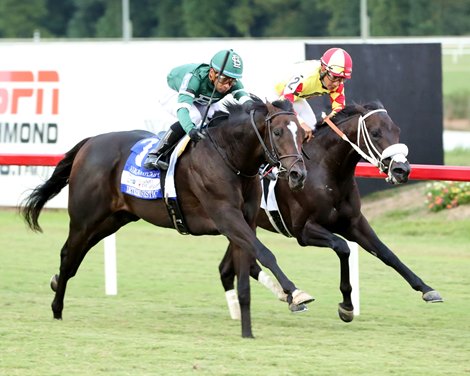This year’s Belmont Stakes (G1) will be held June 8, but there is a notable twist to the final jewel of the 2024 Triple Crown.
The race typically is held at Belmont Park in Elmont, N.Y., however the famed racetrack currently is undergoing a massive renovation, and that construction forced the race to be moved to upstate New York for two years (2024 and 2025) where it will be held at Saratoga Race Course in Saratoga Springs, N.Y., another iconic horse racing venue.
The prospective field for the Belmont Stakes looks especially strong with Kentucky Derby (G1) winner Mystik Dan among the runners tentatively targeting the race along with Preakness Stakes (G1) winner Seize the Grey , Kentucky Derby runner-up Sierra Leone , 2023 champion 2-year-old male Fierceness , and several other Derby participants slated to compete. To help get you ready for the final jewel of the Triple Crown, below are 17 interesting facts about the race called the “Test of the Champion.”
- The Belmont Stakes is the oldest of the three Triple Crown races. It was first held in 1867, and this year is the 156th running, compared with the 150th Derby and 149th Preakness. The Belmont Stakes is the fourth-oldest stakes race in North America. The Phoenix Stakes at Keeneland was first run in 1831, the King’s Plate in Canada held its inaugural race in 1860, and the Travers Stakes started at Saratoga in 1864.
- The 2020 Belmont Stakes marked the first time since 1925 that the race was not contested at its famed 1 1/2-mile distance, and for the next two years (2024 and 2025) it will be held at 1 1/4 miles. The COVID-19 pandemic led to many racetracks being temporarily shut down, the postponement or cancellation of key races on the Triple Crown trail, and the interruption of training schedules for trainers and their racehorses. That prompted the Belmont Stakes to be held at 1 1/8 miles around one turn and scheduled as the first leg of the Triple Crown instead of the last one for the first time in the race’s history. The race returned to its normal distance and placement as the final leg of the Triple Crown for the next three editions, but the construction project underway at Belmont Park led to changes again … starting this year. Belmont Park features a 1 1/2-mile oval, while Saratoga Race Course is a one-mile main track. Saratoga’s layout makes it nearly impossible to hold 1 1/2-mile races on the main track, thus the Belmont Stakes will be held at 1 1/4 miles for the next two years. That’s the same distance as the Kentucky Derby and Saratoga’s signature summer race, the Travers Stakes.
- A record crowd of 120,139 turned out to watch Smarty Jones vie for the Triple Crown in 2004. The fan favorite was beaten by 36-1 longshot Birdstone . The second-largest crowd of 103,322 came two years beforehand when 70.25-1 Sarava upset War Emblem in the latter’s bid for a Triple Crown in 2002. Sarava was trained by Kenny McPeek, who could have two contenders for this year’s Belmont Stakes in the aforementioned Mystik Dan and Kentucky Oaks (G1) winner Thorpedo Anna . Neither will be 70-1!
- Historically, the betting favorite has won the Belmont Stakes 43% of the time (66 of 155 runnings) and four of the last six editions featured winning favorites: Mo Donegal (2022), Essential Quality (2021), Tiz the Law (2020), and Justify (2018). Sir Winston in 2019 paid $22.40 for a $2 win bet and Arcangelo last year was the fifth choice in the betting, returning $17.80 for a $2 win bet.
- A pair of Triple Crown winners owns the two largest winning margins in the Belmont. Secretariat won by 31 lengths in 1973 and Count Fleet won by 25 lengths 30 years prior. Who owns the largest winning margin in the Belmont Stakes since Secretariat? Well, that would be Secretariat’s son Risen Star, who in 1988 won the Belmont Stakes by 14 3/4 lengths in a breathtaking performance.
- Speaking of Secretariat, the 1973 Triple Crown winner set a world record for 1 1/2 miles on the dirt when he won the 1973 Belmont in 2:24. He was so fast that Secretariat also holds the record for the fastest half-mile, three-quarters of a mile, one-mile, and 1 1/4-mile fractions in Belmont Stakes history. Obviously, there is no chance for the 1 1/2-mile stakes record to be broken in 2024 because of the distance change to 1 1/4 miles. Could Secretariat’s 1 1/4-mile fractional time of 1:59 be bettered? Considering the stakes record for the 1 1/4-mile Travers Stakes, the “Mid-Summer Derby” at Saratoga, is 1:59.36 set by Arrogate in 2016, it seems extraordinarily unlikely but much more realistic than 1 1/2 miles in less than 2:24.
- The first Belmont Stakes featured a total purse of $2,500, with the filly Ruthless taking home the $1,850 winner’s share. This year’s race is worth $2 million, including $1.2 million for the winner.
- From 1882-88, jockey James McLaughlin won six editions of the Belmont Stakes in the span of seven years. McLaughlin established the record for the most Belmont wins by a jockey that Eddie Arcaro equaled in 1955 with his sixth and final Belmont Stakes victory aboard Nashua. The leading active rider is Mike Smith with three wins in the race: Drosselmeyer (2010), Palace Malice (2013), and Justify (2018).
- Trainer James Rowe Sr. in 1913 won his eighth Belmont Stakes with Prince Eugene, establishing a record that has never been broken. Rowe also won the Belmont twice as a jockey in 1872 on Joe Daniels and 1873 aboard Springbok. The only other person to both ride and train a Belmont Stakes winner is George Martin Odom, who rode Delhi (1904) to victory and in 1938 saddled winner Pasteurized.
- The leading active trainers by Belmont Stakes victories are Hall of Famers D. Wayne Lukas and Todd Pletcher (a former assistant to Lukas) with four each. Lukas won the race with Tabasco Cat (1994), Thunder Gulch (1995), Editor’s Note (1996), and Commendable (2000). Pletcher’s victories came with the filly Rags to Riches in 2007 as well as Palace Malice (2013), Tapwrit (2017), and Mo Donegal (2022). Lukas and Pletcher both have a chance to add to that total in 2024. Lukas is targeting the race with Seize the Grey, while Pletcher currently has at least two candidates in Fierceness and Peter Pan Stakes (G3) winner Antiquarian .
- Julie Krone in the 1993 Belmont Stakes became the first woman to ride a winner in a United States Triple Crown race. Krone guided longshot Colonial Affair from off the pace to win by 2 1/4 lengths.
- Last year, 30 years after Krone’s accomplishment, Jena Antonucci became the first woman to train the winner of the Belmont Stakes when Arcangelo scored by 1 1/2 lengths. Antonucci was only the 11th woman to saddle a horse in the “Test of the Champion” and the first since 2011.
- The aforementioned Sarava gave bettors the biggest win payout in the history of the Belmont at odds of 70.25-1. His 2002 win earned bettors $142.50 for every $2 bet and the $2 exacta with runner-up Medaglia d’Oro paid $2,454 after Kentucky Derby and Preakness winner War Emblem stumbled at the start and finished eighth.
- The 1921 Belmont Stakes was the first to be run in the counter-clockwise direction. That year, the 53rd running of the Belmont Stakes was a 1 3/8-mile race on the main track. Previous editions had been run clockwise, in accordance with English custom, on a fish-hook-shaped course that included part of the training track and the main dirt oval.
- Twenty-one editions of the Belmont Stakes have been won by horses whose names began with the letter C, most recently Creator in 2016. The letter S ranks second with 19 winners, while no Belmont winner’s name has ever started with the letters X or Y. Arcangelo in 2023 became the 12th winner whose name began with the letter A.
- Tiz the Law in 2020 became the first New York-bred winner of the Belmont Stakes in a remarkable 138 years. He joined Ruthless (1867), Fenian (1869), and Forester (1882) in the history books as the only New York-bred winners of the race.
- Seize the Grey will try to become the 19th non-Triple Crown winner to complete the Preakness-Belmont Stakes double and the first since Afleet Alex in 2005. Obviously, the 13 Triple Crown winners also won both races, but the Arrogate colt can join Cloverbrook (1877), Duke Of Magenta (1878), Grenada (1880), Saunterer (1881), Belmar (1895), Man o’ War (1920), Pillory (1922), Bimelech (1940), Capot (1949), Native Dancer (1953), Nashua (1955), Damascus (1967), Little Current (1974), Risen Star (1988), Hansel (1991), Tabasco Cat (1994), Point Given (2001), and the aforementioned Afleet Alex.










Leave feedback about this